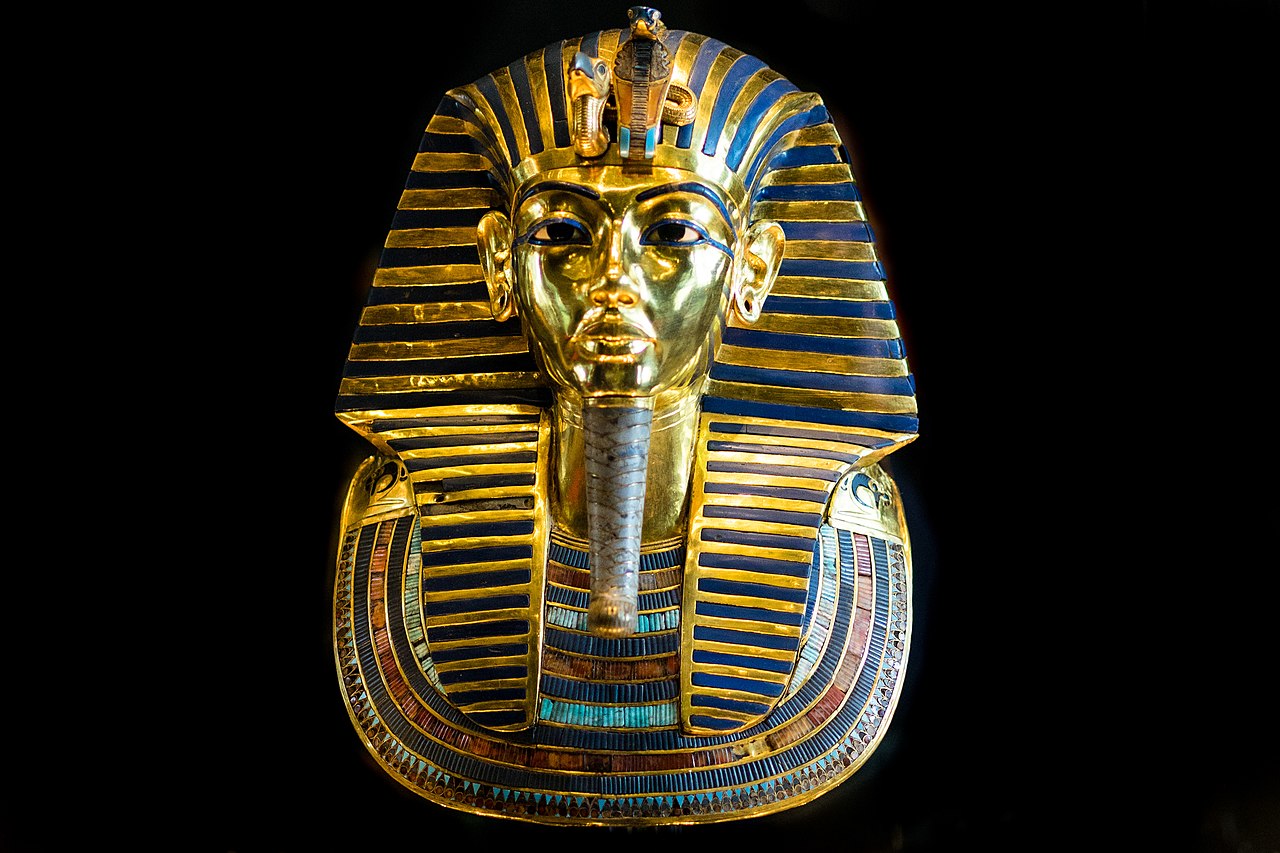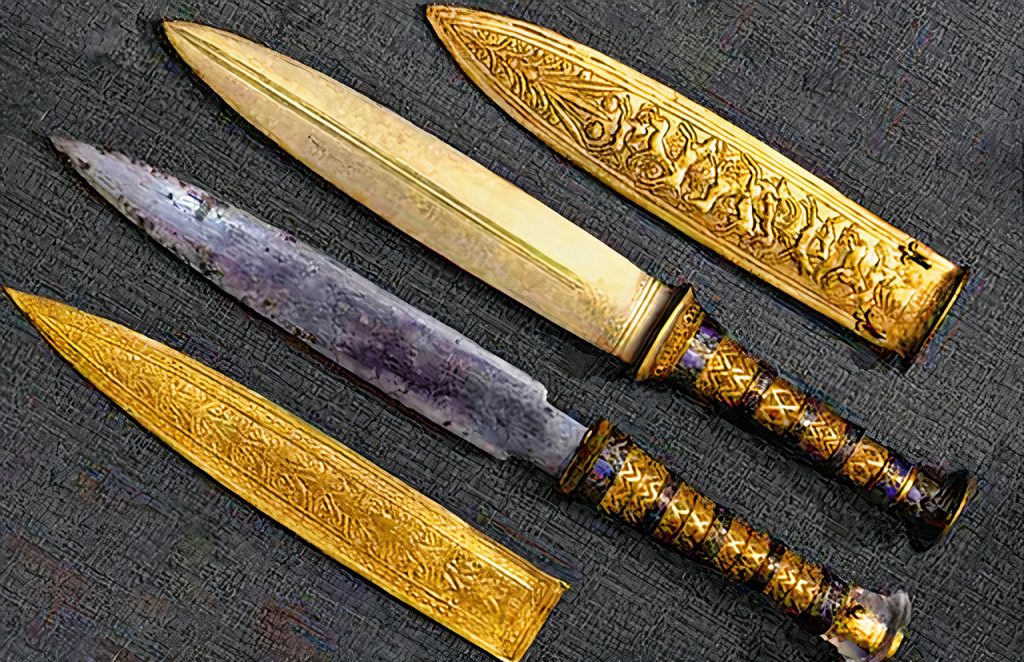Summary
- Howard Carter discovered the tomb of Tutankhamun 101 years ago today.
- Tutankhamun was most likely the son of the heretic pharaoh, Akhenaten and his wife, Kiya.
- Tutankhamun reversed his father’s controversial experiment with monotheism and restored the cult of Amun to power.
- The young pharaoh met an untimely demise at a young age, however, there is no consensus about the cause of his death.
- Howard Carter came to Egypt as an archeological artist and worked his way into overseeing excavations, where he made the acquaintance of the Earl of Carnarvon.
- Lord Carnarvon financed the expedition that brought to light one of the most fascinating tombs in recent history.
- The remains of the young pharaoh and thousands of grave goods sparked ‘Egyptomania’ that continues to mesmerize an entire world.
The Parents of Tutankhamun
The birth of Nebkheperure Tutankhamun and the identity of his parents remains a debated subject amongst Egyptologists. He was born in 1344 BCE in modern-day Amarna during the 11th year of Amenhotep IV or Akhenaten‘s reign. There is generally a consensus that Akhenaten was the father, however, the identity of his mother cannot be confirmed as there are no records in the inscriptions. While some believe his mother was the famous queen Nefertiti, academics generally agree that his mother was most likely one of Akhenaten’s lesser-known wives, Kiya.
Rise of the Aten
First documented during the Twelfth Dynasty, the Aten was represented by a solar disk emitting rays in the form of human hands. While the Aten was already a revered deity during the reign of Amenhotep III, it was during the reign of the infamous heretic king, Amenhotep IV that Atenism was deemed the official state religion. Amenhotep IV, better known as Akhenaten, was responsible for ancient Egypt’s brief but tumultuous dalliance with monotheism.
While it cannot be confirmed why Akhenaten ordained this drastic shift in thousands of years of Egyptian religion, it was likely politically motivated. In the long course of ancient Egyptian history, the priesthood of Amun had become exceedingly wealthy and influential, rivaling the power and influence wielded by the royal family.
Sometime after the fifth year of his reign, Akhenaten completely turned his back on the old gods and began a violent quest to eradicate them from existence. Armed forces were deployed to destroy their imagery and chisel their names from temple walls. Akhenaten proclaimed himself as the living incarnation of Aten and his sole messenger. He built temples dedicated to the Aten and moved the capital from Thebes to a location on the east bank of the Nile River in the modern-day province of Minya. This city known as Akhetaten or the “horizon of the Aten” was destroyed upon the heretic king’s demise.

Relief work on a domestic altar depicting Akhenaten and Nefertiti with three daughters beneath the Aten. Neues Museum, Berlin, Germany. Photograph by José Luiz Bernardes Ribeiro via Wikimedia Commons (CC BY-SA 4.0).
Ascension to Power
After the death of Akhenaten, there were two intermediate rulers before the ascension of Tutankhamun about whom very little is known. Tutankhamun came into power in 1332 BCE at the age of 9. Tutankhamun’s reign was a time of great geopolitical turmoil with the growing power of the Hittites. However, it was his domestic policy that would be his most prominent legacy. Under the influence of his advisors, Tutankhamun restored order to Egypt by instituting a reversal of Akhenaten’s religious experiment, making this relatively insignificant pharaoh’s reign an important turning point in the course of pharaonic history.
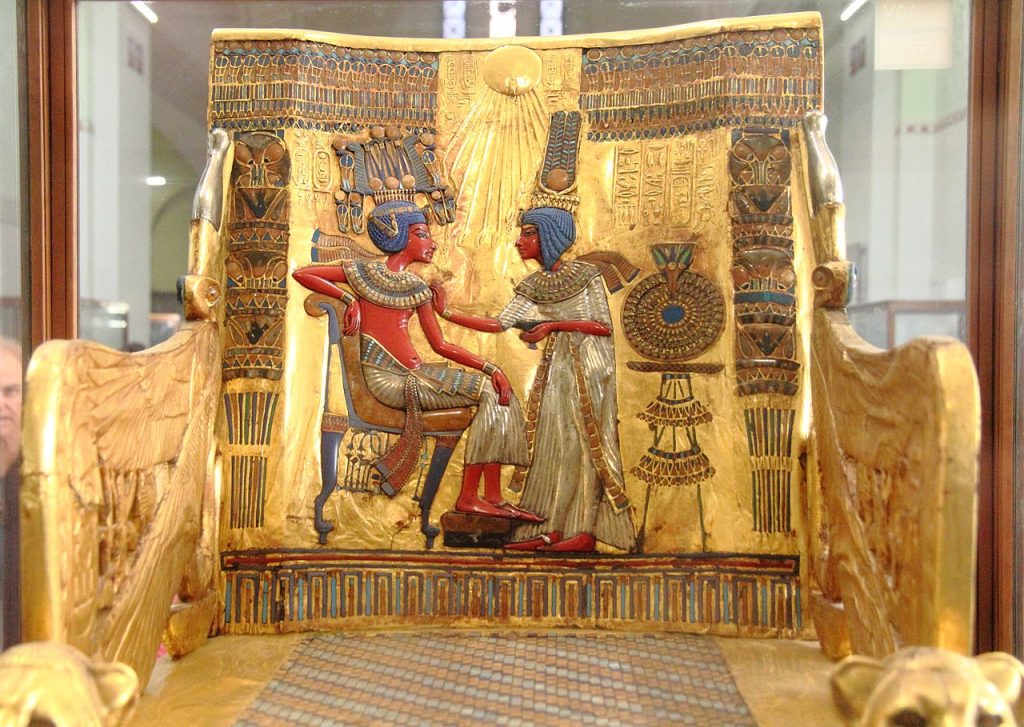
View of the Gilded Throne of Tutankhamun with depictions of the Aten. Photograph by Djehouty at the Egyptian Museum, Cairo via Wikimedia Commons (CC-BY-SA-4.0).
The Restoration of the Cult of Amun
Tutankhamun’s birth name was Tutankhaten or the “living image of Aten” and upon his ascension, he adopted the name Tutankhamun or the “living image of Amun”. The change in the name was a significant political gesture and a rejection of his father’s controversial religious convictions. The young ruler moved the capital back to Thebes and decreed the restoration of the temples, traditional art, and iconography that had been set aside or hidden during the reign of Akhenaten.
The abandonment of the old gods likely had a devastating effect on this deeply religious society, so the restoration measures were warmly welcomed by the general public. Raised relief work and statuary depict the likeness of Tutankhamun with motifs of the old gods and paying homage to the old religion.

Colossal Statue of Tutankhamun, 1355-1315 BCE, Funerary Temple of Ay and Horembheb, Luxor, Egypt. Photograph by Dmitry Denisenkov via Wikimedia Commons (CC-BY-SA-2.0).
Depictions of Tutankhamun
There are several figurative forms including relief work and statuary that depict the young pharaoh, but it is important to note that these are most likely idealized depictions that were driven by royal propaganda. Medical testing in recent years confirms that Tutankhamun was likely a sickly young man who ambulated slowly with a limp.

Statue of Amun with features of Tutankhamun, Karnak Temple of Amun-Ra, Luxor, Egypt. Photograph by Markh via Wikimedia Commons.
The Death of Tutankhamun
Studies confirm that Tutankhamun died at the age of 18 or 19, around the January of 1327 BCE, however, the cause of his death remains hotly debated. It has been speculated that he died from an infection caused by an abscessed tooth or a broken leg, perhaps as a result of a hunting accident. It remains evident that his body suffered from damage that resulted either immediately before or immediately after his untimely demise. The damage has been attributed to a hasty mummification process.

Indurated limestone head of Tutankhamun, ca. 1336–1327 B.C. The Metropolitan Museum of Art, New York, NY, USA.
Howard Carter
Egypt has attracted foreign visitors since the time of the Romans and tourism saw a boost with the proliferation of an extensive canal and railway network in the early 20th century. Seventeen-year-old English watercolorist, Howard Carter made his first trip to Egypt to pursue a job as an archeological artist. Over time he established himself as a history and archeology expert despite having no formal education in either realm.

Photograph of Howard Carter, 1924, National Photo Company Collection, Library of Congress Prints and Photographs Division Washington, D.C. USA. Photo courtesy of the Library of Congress.
Fifth Earl of Carnarvon
George Edward Stanhope Molyneux Herbert, the fifth Earl of Carnarvon first came to Egypt to spend the winter as a respite for his ailing health but was drawn into Egypt’s tantalizing history. He became a financier for several archeological expeditions in Egypt and was introduced to Carter during these pursuits. By the year 1922, Lord Carnarvon had grown weary of the archeological endeavors but was convinced by Carter to just fund one more season of fieldwork. In November of that year, Lord Carnarvon and Carter opened the door to what became known, as KV-62 and the world’s most coveted archeological find.
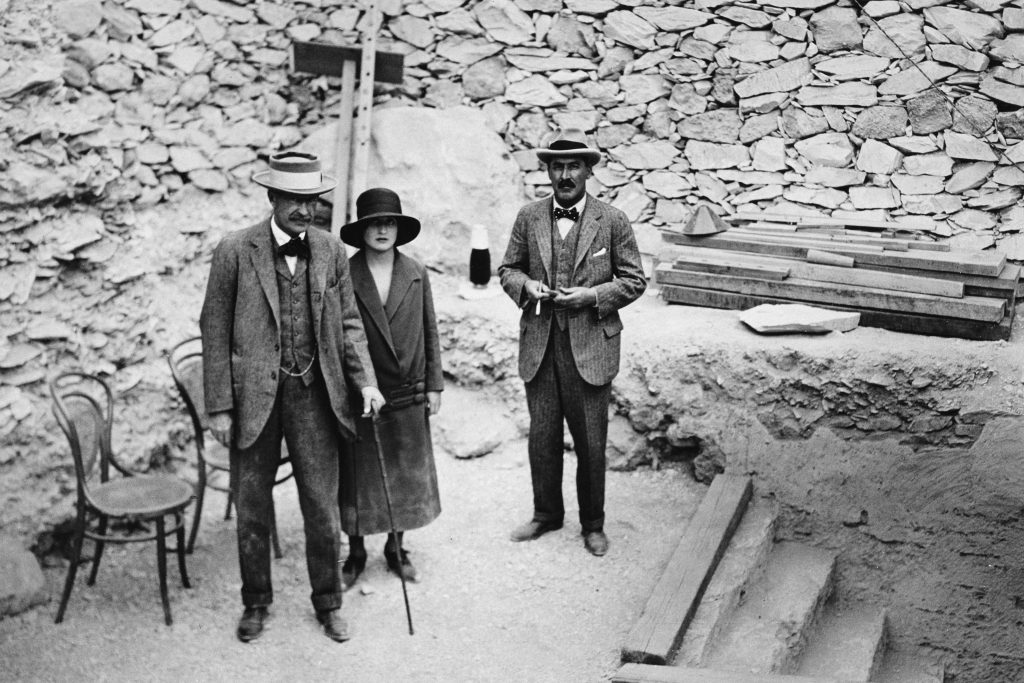
Lord Carnarvon (left) with his daughter Lady Evelyn Herbert (center) and Howard Carter (right) at the steps down to Tutankhamun’s tomb, 1922, The Times Archives.
Unexpected Location of the Tomb
The relatively smaller and relative location of the KV-62 in the East Valley of the Kings has baffled Egyptologists for a hundred years! This cramped tomb was more fitting for a nobleman rather than a pharaoh, and Tutankhamun would have been expected to have been buried in the western arm of the Valley of the Kings along with his predecessors. Some experts have suggested that Tutankhamun’s death was so unexpected that there was no time for a royal tomb to be commissioned. However, many disagree with this theory as tomb construction started during the lifetime of the pharaoh and was often completed within a year or two.
A far more likely explanation for this rather undignified location was that Tutankhamun’s advisor and successor, Ay made a strategic swap and buried the young pharaoh in a tomb originally intended for himself, while Ay, who died four years into his pharaonic reign was buried in a grand tomb in the West Valley, close to the tomb of Amenhotep III.

Photographs of Tutankhamun’s tomb by Harry Burton representing the excavations of the tomb of Tutankhamun and its contents. Vol. 1, ca. 1922, Wikimedia Commons (public domain).
Discovery of the Tomb
Gravy robbery had already been rampant in antiquity, and by the time of Carter’s discovery, most royal burials had been discovered and looted. The tomb of Tutankhamun was, therefore, the only near-intact pharaonic tomb, making the scale and significance of this discovery unparalleled. It was unlike anything the world had ever seen before and this boy-king from another era became an overnight celebrity more than three thousand years after his reign.
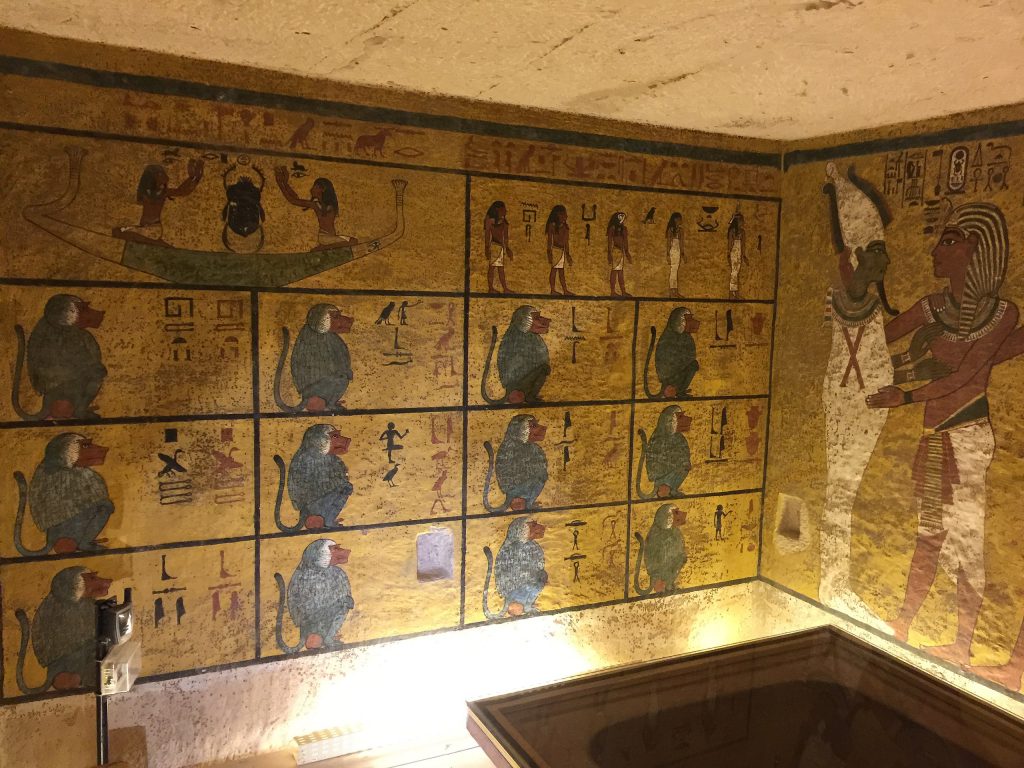
Interior View of Tutankhamun’s Tomb. Photograph by EditorfromMars via Wikimedia Commons (CC-BY-SA-4.0).
The World’s Most Expensive Coffin
Carter had discovered what is no doubt the world’s most expensive coffin. Tutankhamun’s final resting place comprised three nesting coffins encased in a rectangular stone sarcophagus.
The two outer coffins were made of wood encased with gold sheets, while the innermost coffin is made of thick sheets of beaten gold. The coffins are in anthropoid form with representations of Osiris laying on his back with a crook and flail within crossed arms, the symbols of kingship. Curiously the middle coffin features an unidentified face that is different from the other two coffins and unlike the death mask of Tutankhamun suggesting overwhelmingly that the pharaoh was buried in a coffin intended for someone else.

Photograph of Howard Carter and a staff member examining the innermost sarcophagus of Tutankhamun, 1925, Luxor, Egypt, Griffith Institute, University of Oxford, Oxford, UK. Colorized by Dynamichrome.
The Missing Heart of Tutankhamun
The mummification process of Tutankhamun appears to have been hastily executed. Significant bodily damage is evident that may have occurred during the mummification. In the curious ancient process, the brain was typically discarded while the heart, which was regarded as the home to the soul, was preserved. The heart was left in place or sewn back into the body if it was accidentally removed. However, Tutankhamun’s remains did not include a heart. Whether this was due to the carelessness of his undertakers, or because the pharaoh died far from home causing the heart to decay before it could be mummified, remains another mystery.

Calcite canopic chest of Tutankhamun, Egypt 1332-1323 BCE, Egyptian Museum, Cairo, Egypt. Photograph by Mary Harrsch via Flickr.
Funerary Goods
Tutankhamun was laid to rest surrounded by over 5,000 precious objects including religious items, artwork, furniture, musical instruments, board games, jewelry, jars of beer and wine, etc. that provide tantalizing clues into the daily lives of the young pharaoh and ancient Egyptian royalty. Carter spent the next decade studying the artifacts revealed in the tomb and overseeing its clearance.
Remains of the Offspring
Buried alongside the pharaoh were two stillborn offspring of Tutankhamun and his consort and half-sister, Ankhsenamun. Ankhsenamun was the daughter of Akhenaten and Nefertiti, and the half-sister of Tutankhamun. The children were possibly stillborn due to congenital defects believed to be the result of the incestuous relationship between their parents, a common practice in ancient Egyptian royalty.
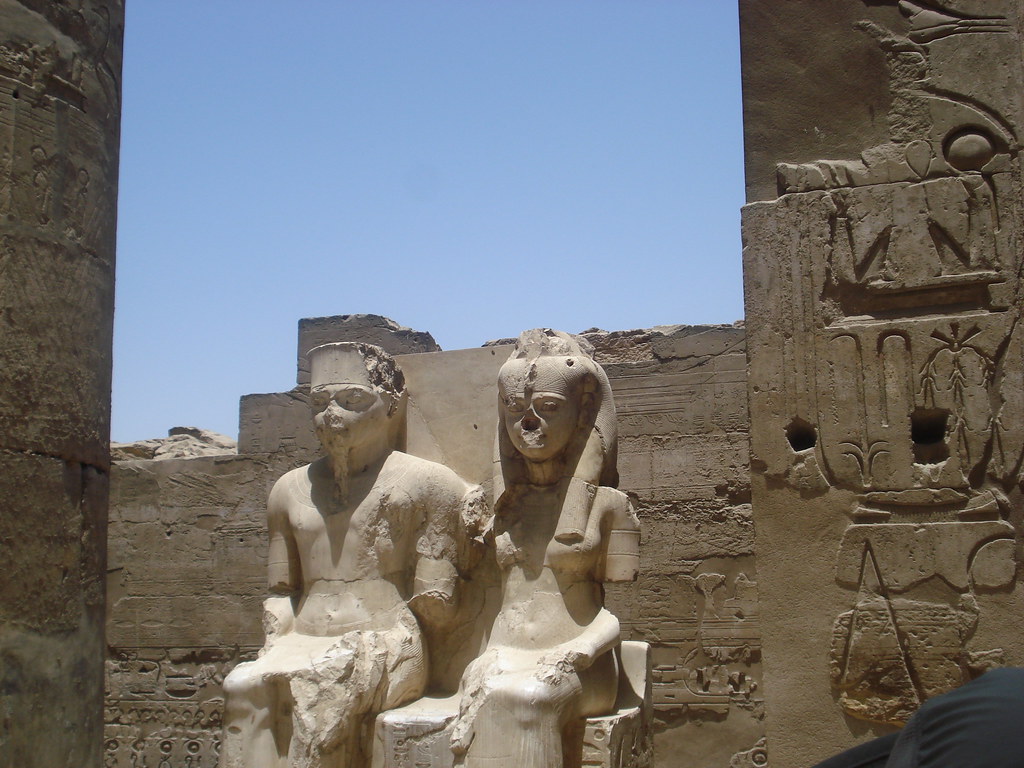
Statue of Tutankhamun and his wife Ankesenamun, Luxor Temple, Luxor, Egypt. Posted by Kate Calle via Flikr.
The Curse of Tutankhamun
The discovery of the young king’s tomb was an overnight press sensation throughout the world. Soon after the discovery, Lord Carnarvon succumbed to a fatal infection and never made it back home to England. Several newspapers regurgitated the story of a curse that has been repeatedly dismissed by academics including Carter. No curse was ever found on the tomb, and most people who worked in or visited the tomb went on to live long lives.

Photograph of the unbroken rope seal of Tutankhamun’s burial chamber, 1922, Luxor, Egipt. Reddit.
Impact of the Discovery
The Amarna period was a dark era for the ancient Egyptian people, and the subsequent pharaohs removed deliberately erased the names of Tutankhamun and Akhenaten from historical records. It is ironic that a young pharaoh that was not intended to be remembered would become a modern-day celebrity over three thousand years after his demise. It is also unlikely that either Lord Carnarvon or Carter could have appreciated the enormous impact of their discovery and its continuing hold on human interest in the 21st century. The discovery of Tutankhamun has been an absolute thrill for enthusiasts and has piqued a worldwide interest in Egyptology that remains strong even now 101 years later.
